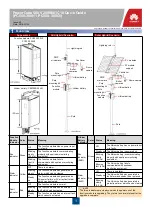
KLP-HV 070312
2-9
WARNING
IT IS IMPERATIVE THAT THE USER PROVIDE ALL THREE SOURCE
WIRE CONNECTIONS, AS THIS CONNECTION IS THE SAFETY
GROUND PROVISION!
2.7.3
D-C OUTPUT GROUNDING
Connections between the power supply and the load and sensing connections may, despite pre-
cautions such as shielding, twisting of wire pairs, etc., be influenced by radiated noise, or “pick-
up”. To minimize the effects of this radiated noise the user should consider grounding one side
of the power supply/load circuit. The success of d-c grounding requires careful analysis of each
specific application, however, and this recommendation can only serve as a general guideline.
One of the most important considerations in establishing a successful grounding scheme is to
avoid GROUND LOOPS. Ground loops are created when two or more points are grounded at
different physical locations along the output circuit. Due to the interconnection impedance
between the separated grounding points, a difference voltage and resultant current flow is
superimposed on the load. The effect of this ground loop can be anything from an undesirable
increase in output noise to disruption of power supply and/or load operation. The only way to
avoid ground loops is to ensure that the entire output/load circuit is fully isolated from ground,
and only then establish a single point along the output/load circuit as the single-wire ground
point.
The exact location of the “best” d-c ground point is entirely dependent upon the specific applica-
tion, and its selection requires a combination of analysis, good judgement and some amount of
empirical testing. If there is a choice in selecting either the positive or negative output of the
power supply for the d-c ground point, both sides should be tried, and preference given to the
ground point producing the least noise. For single, isolated loads the d-c ground point is often
best located directly at one of the output terminals of the power supply; when remote error sens-
ing is employed, d-c ground may be established at the point of sense lead attachment. In the
specific case of an internally-grounded load, the d-c ground point is automatically established at
the load.
The power supply output terminals (located on the rear panel) for KLP Power Supplies are d-c
isolated (“floating”) from the chassis in order to permit the user maximum flexibility in selecting
the best single point ground location. Output ripple specifications as measured at the output are
equally valid for either side grounded. Care must be taken in measuring the ripple and noise at
the power supply: measuring devices which are a-c line operated can often introduce additional
ripple and noise into the circuit.
There is, unfortunately, no “best” method for interconnecting the load and power supply. Individ-
ual applications, location and nature of the load require careful analysis in each case. It is hoped
that the preceding paragraphs will be of some assistance in most cases. For help in special
applications or difficult problems, consult directly with Kepco's Application Engineering Depart-
ment.
Summary of Contents for KLP 10-150-2
Page 2: ......
Page 6: ......
Page 12: ...vi KLP070312 FIGURE 1 1 KLP SERIES POWER SUPPLY...
Page 19: ...KLP 070312 1 7 FIGURE 1 3 KLP SERIES POWER SUPPLY MECHANICAL OUTLINE DRAWING SHEET 1 OF 2...
Page 20: ...1 8 KLP 070312 FIGURE 1 3 KLP SERIES POWER SUPPLY MECHANICAL OUTLINE DRAWING SHEET 2 OF 2...
Page 27: ...KLP HV 070312 2 3 FIGURE 2 2 KLP SERIES REAR PANEL SWITCH AND CONNECTORS...
Page 40: ......
Page 78: ......
Page 90: ......
















































